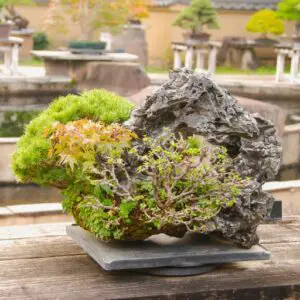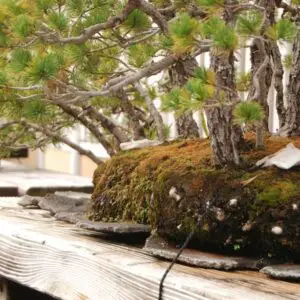A bonsai tree does not need a special pot. Some of the alternative containers for bonsai include stone and rock, wooden boxes, driftwood, baskets made from natural fibers, seashells, cups, plates, and broken ceramics.
Choosing the Right Alternative Container for bonsai

Porcelain bonsai pot
While bonsai pots are the traditional containers for bonsai trees, they may not always be readily available or the most affordable option. If you’re looking for alternatives to bonsai pots, there are many creative and unique options that can add an extra touch of personality to your bonsai collection.
That said, it is important to choose the right kind of container to ensure the health and well-being of your bonsai tree. “It looks nice” isn’t enough when it comes to choosing alternative containers. A poorly chosen container can harm the tree’s growth or impact its overall health.
To ensure the health of your bonsai, it is important that a container meets certain requirements. Four key elements to consider are;
- size
- material
- drainage, and
- aesthetics.
Size
A container for a bonsai tree should be much shallower and smaller than a normal potting container to maintain the bonsai form. For bonsai trees, restricted root growth is a crucial part of the style and helps to keep the tree small. It will grow to be a normal tree if it is planted in a normal size, deep container, which is not what you want for a bonsai tree.
Material
For a sound growth of the root system, a bonsai container should allow roots to aerate, and retain water but drain it as well at the same time. In this sense, clay-like material, wood or natural fiber is good as a bonsai container.
Avoid using containers made of copper, aluminum, or other reactive metals that can leach into the soil and harm the roots of the tree.
Drainage
Proper drainage is crucial for the health of your bonsai tree. Choose a container that has holes of appropriate size or other means of allowing excess water to drain from the roots.
Aesthetic
Finally, choose a container that complements the style of your bonsai tree. It should represent the natural landscape you want to create and complement the tree in color and form.
For more in detail, please check the following post.
By considering these factors, you can choose an alternative container that not only looks nice but also supports the health and well-being of your bonsai tree.
Alternative bonsai pot ideas
From repurposed household items to natural materials, there is no shortage of options for bonsai containers. Here are some of the ideas to add a touch of creativity or simply more budget-friendly options.
Natural containers
Natural containers can provide a rustic and organic feel to your bonsai collection. By using materials from nature, you can create a seamless connection between the bonsai tree and its container. Here are some natural container ideas to consider:
- Stone and rock
- Wooden boxes and trays
- Driftwood
- Baskets made from natural fibers
- Seashells
Stone and rock
Stone and rock formations can be a beautiful option for bonsai containers. They come in a variety of textures and colors, making them a unique choice for you.

Japanese maple- bonsai on rock
In fact, there is a bonsai style called “bonsai on rock” where a tree is planted and grown on top of one or multiple rocks. This style is meant to emulate the look of a tree growing in a natural rocky environment and gives a unique visual to display bonsai trees.

Bonsai on slate
Another idea is using slate. Slates are flat, smooth stones that can be found in various shapes and sizes. They can be an interesting choice for your bonsai tree as they provide a natural and rustic look to the miniature landscape.
Wooden boxes
Wooden boxes can add a warm and natural touch to your bonsai collection.
They are readily available in a variety of sizes and styles, making it easy to find the perfect one to fit your bonsai tree. Also, wood as a material is good for roots as it allows roots to aerate and retains but drains water at the same time. It is easy to deal with and you can make drainage holes if you want to.
You can use an antique wooden box as well, which gives you a more rustic, zen-like aesthetic to your bonsai tree.
Driftwoods

Driftwood can create a unique and naturalistic appearance for a bonsai tree. It is budget-friendly as you can look for one at the riverbed or beach for free.
Make sure to clean and sanitize it before using it as a bonsai container. Scrub it using a brush and put it in clean water. When the water turns into tea color, change the water. After soaking it for one to two weeks, the water should no longer be colored and it is ready to be used as a bonsai container.
You can also curve driftwood like a sculpture or glue several pieces together to make a fun and creative container that perfectly matches your bonsai tree.
Baskets Made from Natural Fibers
Baskets made from natural fibers such as wicker, reed, or bamboo can be a great option for bonsai containers. They are often lightweight and drains water well.
Seashells
Seashells are another original bonsai container idea that can add a touch of coastal charm to your bonsai collection.
They come in all sorts of shapes, sizes, and colors, making them a unique option for your bonsai trees. It should be more so if you live far away from the coast. Using seashells as a container can create a beach-like atmosphere for your bonsai tree, adding a touch of nature that is quite distinctive.
Make sure to drill several holes in the shell.
To do this, first, put the shell on a towel or a cushion to absorb the shock. Push a screw into the shell and gently twist. You may have to use a hammer if the shell is thick and hard. To make a hole bigger, insert the screw again and continue twisting until the hole gets big enough.
Repurposed containers
Repurposed containers are a great alternative to traditional bonsai pots as they are often more affordable and can add a unique touch to your collection. Here are some options to consider.
- Mug cups and teacups
- Plates
- Broken ceramics
Mug cups and teacups
Coffee cups and teacups can add a whimsical touch to your bonsai collection. These are found in a variety of styles and colors and are readily available, making them a fun and budget-friendly option for you.
When using a cup as a bonsai container, do not forget to make drainage holes in the bottom. It is better to choose unglazed pottery rather than glazed because the glaze is a glass coating and can crack when pierced.
Also, the bottom of the cup should have a rim so that all of the surfaces of the cup’s bottom do not touch the ground directly when it is placed. Without a rim, water will be blocked at the outlet even with the drainage holes.
To make a hole for drainage in a cup’s bottom, here is what to do.
- First, put the cup upside down on a towel or a cushion to absorb the shock.
- Cover all of the surfaces of the bottom with duct tape from both inside and outside to avoid making cracks.
- Push a screw in the middle of the cup’s bottom and gently twist.
- After making a small hole, push the screw very, very gently using a hammer until it becomes big enough for drainage.
- Peel off the duct tape gently not to damage the hole you made.
Plates
Plates are another option to consider as a bonsai container. They provide ample surface area for the roots to spread, while still maintaining a shallow depth that is ideal for bonsai trees.
Make sure to drill drainage holes in the bottom. If you can, choose unglazed pottery rather than glazed because the glaze is a glass coating and can crack when pierced.
Broken ceramics
Broken pieces of ceramic or pottery, such as teacups or plates, can be used as containers for bonsai trees. These pieces can be arranged together to create a unique and artistic display as well. Broken ceramics can add an interesting texture and color and can create a rustic and natural look for the bonsai tree.
Make sure ensure that the broken pieces are arranged in a way that provides proper drainage and does not harm the roots of the bonsai tree.




